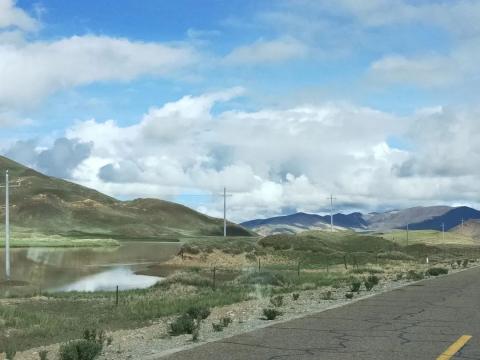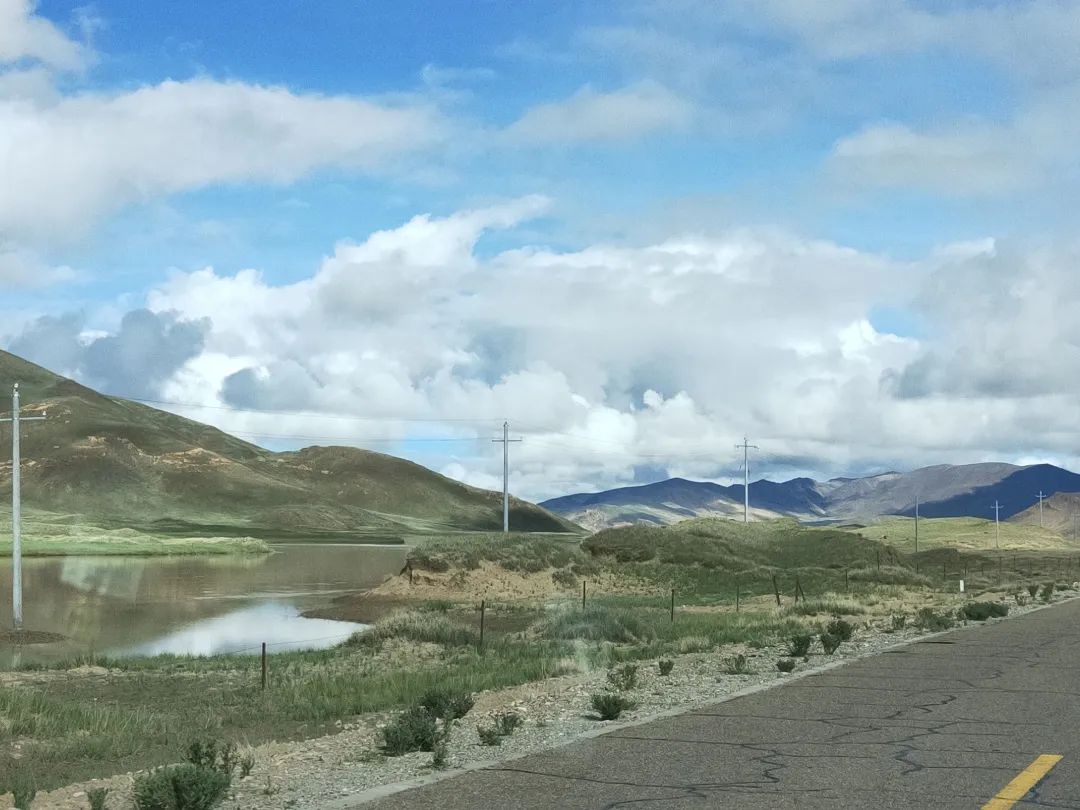
The third day
I got up early in the morning and set out. As soon as I left the county town, I climbed a mountain. The sky was still very cold, like late autumn. Today we have to drive from Saga County to Hall Township at the foot of Mount Kailash.


Occasionally I encountered the ruins of adobe houses on the river bank along the way. Although the driver and the people in the car told me that these were just abandoned houses of local residents, I always felt that these were some kind of "ruins", otherwise why were they built in such places? A place with such dangerous terrain? Why do they all look so much like checkpoints? Could it be that the Gurkhas came along this road when they invaded Tibet? Are these really not military fortresses of the Qing army? Although he was full of doubts, he didn't ask further.


Along the way, we arrived at the source of Yajiang River. The source of the Yajiang River is a huge desert wetland, and the end of the wetland is India. Because of the rain, the sand dunes were moist and solid. We climbed up the sand dunes effortlessly and suddenly saw a clear view before our eyes. The Brahmaputra River flows quietly far away from the road. The rainwater gathers in low places to form puddles. There is a faint cyan color around the puddles. The strong sunshine from the plateau shines down, making the surrounding area very bright. I was surprised to see the desert on the Qinghai-Tibet Plateau. I thought that there was also a large sandy land beside Qinghai Lake, which aroused my curiosity. It was later discovered that this sandy land was formed because the water level dropped in winter, and the sand at the bottom of the river was exposed and blown to the shore by the wind.
The dark clouds behind the mountains are about to move, and it feels like they will come over at any time. Because today’s scenic spots are all natural scenery, I am a little worried that it will rain.




Continuing forward, we passed a gas station to refuel, and a minibus full of foreigners got off the bus next to me. I was shocked, but I guess they were all on a pilgrimage to Mount Kailash. Along the way, I saw more and more blue minibuses like this, all decorated in colorful colors. According to the master, this is also a unique sight on the southern route of Ali. In the past few years, Indian pilgrims would bring their own cooking utensils to cook curry on the roadside.
In the afternoon, we arrived at the junction of Shigatse and Ngari. There is an arch on the road to welcome tourists from afar. After crossing the arch, we finally started a veritable "trip to Ngari". Not far from the arch, we climbed over the first mountain in Ngari. After walking for an unknown amount of time, a patch of blue gradually grew larger on the far side of the road. We finally arrived at Manasarovar Lake.

From the map, the peaks of Manasarovar, Laangtso and Mount Kailash stand on both sides of the national highway. The two lakes face each other across a road bridge. There is a road on the land bridge leading to Pulan County, where there are the ruins of the Pulan Kingdom. According to legend, Master Tsongkhapa split the lake in half when he was practicing here. One half was used by gods to live in and became a holy lake, and the other half was used by ghosts to live in and became a ghost lake. After coming back, I found a lot of older, more fantastical legends about Manasarovar from various religions and sects. We did not enter the Manasarovar scenic area, but drove along the land bridge to view the holy lake from a distance. On the road, I looked at Mount Kailash from a distance. The mountain was covered with dark clouds, like a dark night. Many snow-capped mountains were hidden in the dark clouds. I didn’t know which one was the real one. The master said that this tourist route will pass by Mount Kailash three times in total. Whether you can see the whole snow-capped mountains depends on luck.



Passing by a small temple, we went in for a tour. There are many small temples like this around the holy lake. It is said that there were sectarian disputes in order to build them. The small temple is built on a huge red stone. The steps to go up have not been repaired. A steep dirt road leads to the top. There are many small mani piles on the roadside, some of which have collapsed and were buried among the rubble. , only one stone foundation can be distinguished. We climbed up cautiously, firstly because we were afraid of falling due to lack of oxygen due to lack of oxygen at an altitude of more than 4,500 meters, and also because we were afraid that we would not distinguish between gravel and mani piles built by others and accidentally kick us down. The temple is very small. In my impression, there seems to be only one main hall in the small courtyard, from which the rich fragrance of butter wafts.



Go out from the back door of the small courtyard and face the side of the holy lake. There are several huge mani piles made of rubble on the exposed boulders. They are all red and intertwined with layers of prayer flags. Standing between the mani piles, you can Overlooking Manasarovar. The clouds in the sky thickened, leaving only a few touches of blue, and it began to rain in the mountains in the distance. The clouds were reflected on the lake, and the lake also dimmed, turning into pixel-colored frosted glass. It is still far away from the lake shore, and you can see villages scattered around the lake in the distance. While taking photos, we met an international friend from India who came to visit us. According to him, he spent three days circling the lake.

After coming down from the small temple, we continued driving and arrived at a place very close to the lake. Close to the lake, there was a dirt road for pilgrims to go around the lake. All kinds of pilgrims staggered around the lake with pious hearts. A barbed wire fence hung with prayer flags separates the road from the dirt road. There are people guarding the road. As long as you step in, you have to pay the entrance fee. Although you can see the complete lake surface through the barbed wire fence, when you put it into the camera, you find that this distance is just the right distance to compress the lake surface into a blue line, making it completely impossible to photograph.


We drove all the way to La Ang Tso again. Maybe because it is a "ghost lake" in Tibetan culture, not many pilgrims come here. Only tourists like us come here with the mentality of "come here". The car stopped far away from the lake. There was soft sand inside, and the grassless ground was covered with white salt and alkali. Maybe the tires would get stuck in it.



After getting out of the car, I saw the rough waves of the lake in the distance. The hoarse sound of the waves blew to my ears on the biting and salty lake wind, like the hoarse roar of demons and ghosts sealed in hell. Namunani on the other side of the lake. The white snow on the top of the snow-capped mountains flickers in the clouds. We walked towards the lake in the strong wind, one deep and one shallow, and jumped off the natural lake embankment more than one meter high to reach the water's edge. The turbulent waves carried dead branches and water plants and slapped on the shore. The black lake water reflected the afterglow of the sunset, which made people feel sad. Although the two lakes are not far apart, one is a freshwater lake and the other is a saltwater lake. Although I really want to take a taste to verify it, but when I think about it being called a ghost lake, I might as well forget it.


After returning to Hall Township, we packed our luggage and found a Northeastern dumpling shop next to the "hotel". We chatted with the proprietress and learned that they came from Jiamusi. It was really not easy to be so far away from home. When the dumplings arrived, they were not as "thin-skinned and big-filled" as expected. The lady boss said that the dumplings were made in a pressure cooker and if they were made too large, they would not be cooked properly. I wanted to order a plate of pot-roasted pork for a change, but she told me very honestly that I would definitely not be able to taste it at home at this altitude and told me not to order it. After dinner, it was completely dark outside, and I couldn't see my fingers, so I groped my way back to the "hotel". The altitude here is more than 4,000 meters, and the room is very cold. You have to plug in an electric blanket to fall asleep.

Afraid of cold
Radiology Class 2

